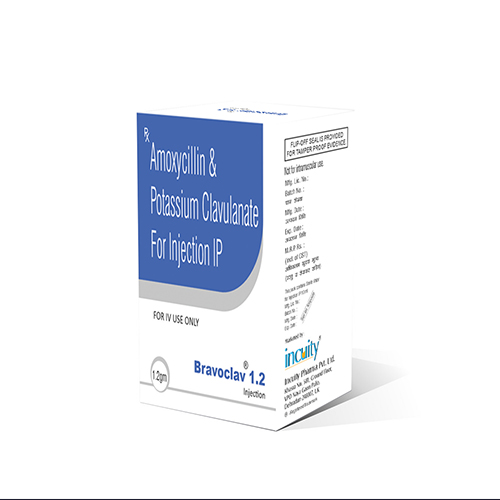Description
Amoxycillin 1000mg Clavulanic Acid 200mg Injection – A combined antibiotic drug called amoxicillin clavulanic acid is used to treat several bacterial infections. Clavulanic acid, a beta-lactamase inhibitor, and amoxicillin, a penicillin-class antibiotic prevent the growth of bacteria. Amoxicillin helps prevent the degradation of amoxicillin by specific bacterial enzymes. By broadening the antibiotic’s range of activity against more types of bacteria, this combination increases its efficacy. For infections of the skin, soft tissues, urinary tract, and respiratory system, amoxicillin clavulanic acid is frequently recommended. To guarantee a safe and efficient course of treatment, use it according
Benefits of Using Amoxicillin Clavulanic Acid
- Amoxicillin and clavulanic acid work together to provide a synergistic effect in which the clavulanic acid helps to suppress the bacterial enzymes (beta-lactamases) that can inactivate the amoxicillin. This improves the drug’s overall effectiveness and makes it possible to eradicate bacteria more successfully.
- It is very helpful when the infection consists of several different species of bacteria or there is a possibility of bacterial resistance. The inclusion of the acid improves treatment outcomes by overcoming bacterial defense systems.
- The drug can be used to treat a variety of common infections, including infections of the skin and soft tissues, respiratory system infections (including pneumonia and bronchitis), urinary tract infections, and more. Due to its adaptability, it is frequently recommended as an antibiotic for numerous bacterial illnesses.
- Amoxicillin clavulanic acid is generally well tolerated by most people and has a low frequency of side effects. Typical side effects are moderate and temporary, although they can include skin rashes, diarrhea, or nausea. To reduce the danger of side effects and achieve the best possible therapeutic results, it is crucial to adhere to the recommended dosage and course of therapy.
How to Use Amoxicillin Clavulanic Acid
- It’s important to take amoxicillin clavulanic acid exactly as your doctor has suggested. This contains the precise quantity of tablets or suspension to take, as well as how often and how long the treatment will last. Without first consulting your doctor, don’t change the dosage.
- To enhance absorption and lessen the risk of gastrointestinal side effects, amoxicillin clavulanic acid is typically taken with food. If your doctor or the drug label specifies that you should take medication before, during, or after meals, heed those directions.
- Even if you feel better before the recommended length of time, it is crucial to finish the entire course of treatment. Premature medication discontinuation increases the risk of illness recurrence or the emergence of antibiotic resistance.
- When using amoxicillin clavulanic acid, it is best to avoid alcohol because it can increase the risk of side effects. Additionally, several substances, including grapefruit juice, may interfere with the drug and lessen its efficacy. For any special dietary restrictions, speak with your doctor or pharmacist.
- Consult your healthcare practitioner right away if you have any queries, worries, or unanticipated side effects while taking amoxicillin clavulanic acid. They can offer advice, modify the course of therapy if necessary, or take care of any other issues.
How Does Amoxicillin Clavulanic Acid Works
- Amoxicillin clavulanic acid functions in two different ways. A penicillin-class antibiotic called amoxicillin prevents bacterial development by interfering with the formation of their cell walls, weakening and ultimately killing them. By preventing specific enzymes (beta-lactamases) produced by bacteria that could render the antibiotic ineffective, clavulanic acid, a beta-lactamase inhibitor, aids in the protection of amoxicillin.
- Beta-lactamases are produced by bacteria and are enzymes that can degrade and render inactive several medicines, including penicillins. Beta-lactamases are competitively inhibited by clavulanic acid, which binds to them and stops them from breaking down amoxicillin. As a result, amoxicillin can continue to work and efficiently target the germs.
- By blocking beta-lactamases, the acid increases the range of amoxicillin’s activity. It makes amoxicillin clavulanic acid effective against a broader variety of bacteria, including certain strains that make beta-lactamases and are invulnerable to amoxicillin alone. In cases of multiple illnesses or suspected bacterial resistance, this combination enhances the likelihood that the therapy will be effective.
- Amoxicillin clavulanic acid has a bactericidal action, which means that rather than just preventing the growth of germs, it destroys them. Amoxicillin weakens the structure of bacteria by preventing the formation of their cell walls, which makes them more vulnerable to the immune system’s defenses and ultimately leads to their death.
Precautions While Using Amoxicillin Clavulanic Acid
- Before taking amoxicillin clavulanic acid, let your doctor know if you’ve ever had a penicillin-class antibiotic, cephalosporin, or other medicine allergy or hypersensitivity. Being cautious is crucial because allergic reactions can range from minor rashes to severe and potentially fatal ones.
- Your doctor may need to change the dosage of amoxicillin clavulanic acid if you have poor kidney function or a history of renal disease. The majority of the medication is removed via the kidneys therefore changing the dosage may be essential to avoid drug buildup and potential side effects.
- Those who have a history of liver disease or who have pre-existing liver issues should be thoroughly watched while taking amoxicillin clavulanic acid. The medicine may result in abnormalities of the liver enzymes; thus, if symptoms of liver dysfunction, such as jaundice or abdominal pain, appear, immediate medical assistance should be sought.
- Be sure to let your doctor know about any of the prescription, over-the-counter, and herbal supplements you are currently taking. Amoxicillin clavulanic acid with some drugs may interact, perhaps reducing the efficacy or raising the possibility of negative side effects.
- Taking antibiotics, such as amoxicillin clavulanic acid, can occasionally result in diarrhea of varying degrees of severity. If you experience frequent, bloody, or watery diarrhea, this could be a symptom of a bacterial illness called pseudomembranous colitis. If you have any symptoms, get in touch with your doctor right away.












